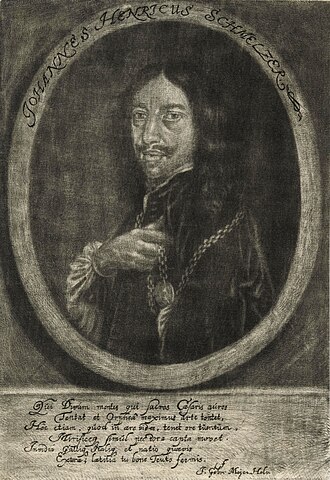Johann Heinrich Schmelzer
Johann Heinrich Schmelzer (born in Austria some time between 1620 and 1623; died in Prague some time between 29 February and 20 March 1680) was a German composer. He was one of the most important composers of instrumental music in the mid-17th century.
Nothing is known about his early life. He became a member of the imperial chapel in the mid 1630’s. His job there was probably a violinist. We know very little about his life, except that over the years he became a famous composer. The emperor must have liked him because he gave him presents of money and gold chains.
In 1671 he became deputy Kapellmeister at the imperial court. In 1673 the emperor gave him the honorary title “von Ehrenruef” which he put after his name. A few years later the court moved to Prague to try to escape the plague that was killing so many people in Vienna. At the end of 1679 the emperor’s Kapellmeister died and Schmelzer became Kapellmeister. It was the first time that the Kapellmeister at the Habsburg court had not been a foreigner but an Austrian.[1] However, the following March Schmelzer died of the plague.
Schmelzer wrote a lot of music for small groups of instruments as well as a lot of ballet music. His dance suites are made up of several dances such as galliard, bourree, sarabande, gigue, gavotte and allemande as well as more unusual dances.[1] He wrote several sonatas for two violins and continuo. They are full of fast scales and arpeggios. He also seems to have written church music, but it has all been lost.
Johann Heinrich Schmelzer Media
Vienna in 1609, drawn in 1609 by Jacob Hoefnagel and recolored in 1640 by Claes Jansz Visscher
References
- ↑ 1.0 1.1 "Schmelzer, Johann Heinrich - Deutsche Biographie". www.deutsche-biographie.de (in Deutsch). Retrieved 2023-03-27.

